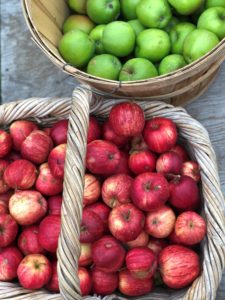 It’s fall. I live in the Pacific Northwest and apples are a big deal here. They are prolific and yummy and I have several apple trees in my small orchard. I have buckets and buckets of them and my daily harvest reminds me of growing up on the Oregon Coast with a mother who said many a day… “an apple a day keeps the doctor away”. I’m thinking she might have been right. While I am a doctor, I’ve been fortunate to not need a doctor almost my whole life….. so far. I’m also wondering if that mantra embedded itself into my love of apples, and even my chosen profession as a physician who specializes in natural therapies and the influence of lifestyle choices on one’s health.
It’s fall. I live in the Pacific Northwest and apples are a big deal here. They are prolific and yummy and I have several apple trees in my small orchard. I have buckets and buckets of them and my daily harvest reminds me of growing up on the Oregon Coast with a mother who said many a day… “an apple a day keeps the doctor away”. I’m thinking she might have been right. While I am a doctor, I’ve been fortunate to not need a doctor almost my whole life….. so far. I’m also wondering if that mantra embedded itself into my love of apples, and even my chosen profession as a physician who specializes in natural therapies and the influence of lifestyle choices on one’s health.
Just to be clear about this love of apples. I not only grow apples, but I seek abandoned apple trees for foraging; leaving enough for others, including the deer and elk out here in the country. But also, there are SO MANY urban neighborhood apple trees, often unpicked and usually free for the asking.
My favorite apple is one in its crunchy sweet youth phase. As I understand it, European settlers brought apples with them to the Americas. They tasted better than the native crabapple which is small and tart—not my favorite.
While there are many types of apples grown in the U.S. today, the varieties we typically see in the stores have become a small list, compared to what is out there. The typical varieties in the stores are the
- Red Delicious
- McIntosh
- Crispin
- Gala
- Granny Smith
- Fuji
- Honeycrisp
- Gravenstein
I encourage you to check out the less common heirloom apples at farmer’s markets or the heritage apples—the apples of our grandparents and great grandparents. Today’s commercial enterprises have focused on the short list, although growers still sell around 90 different types in the U.S. However, compare that with more than 14,000 varieties that were catalogued in 1905 by the U.S. Department of Agriculture. By 2000, more than 11,000 American varieties were believed to have gone extinct. So sad.
Apples are fabulous in their range of use including fresh eating, drying, frying, baking, ciders, juice, vinegar, sauces, jams and butters and more. I forgot the pies!!! Before I leave this praising of apples, they also have health benefits…thanks in large part to their fiber (the pectin) and the flavonoids. However, you have to leave the skin on to get the robust amount of fiber and flavonoids the apple has to offer you. The fiber and the flavonoids in apples also offer some cardiovascular benefits, lowering cholesterol and providing antioxidant support to blood vessels. The fiber can also aid digestion resulting in normalizing bowel habits and perhaps lessen the effects of stomach acid reflux.
If you are looking for a low sodium, low fat, no cholesterol food, apples are your food. They don’t have protein, but they do have vitamin C and as I said the fiber and the flavonoids. They are also low in calories at 100 calories for a medium size apple. They do have 25 grams of carbohydrates with 19 grams of sugar, so some of you need to factor that in, but the 4 grams of fiber help those carbs/sugars to have a friendlier effect on your blood sugar than simple carbohydrates. Be mindful though of how many carbs/sugars you are putting in your system on a daily basis. The whole apple is the ideal way to go rather than the concentrated juice—too many sugars and not much fiber that way.
Lastly, a little bit of mythology and mysticism. To the Iroquois, the apple tree is the Central Tree of Life. In the bible, the apple tree was regarded as the Tree of Knowledge and Tree of Immortality. The Greek mythology is much more diverse with some involving love, others inciting war.
For me, it’s nostalgia, good memories, good food, healthy food and good clean fun for the picking.

